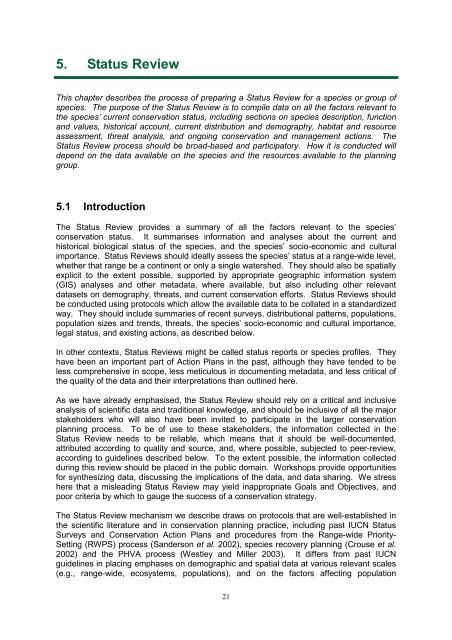Strategic Planning for Species Conservation: A Handbook - IUCN
Strategic Planning for Species Conservation: A Handbook - IUCN
Strategic Planning for Species Conservation: A Handbook - IUCN
Create successful ePaper yourself
Turn your PDF publications into a flip-book with our unique Google optimized e-Paper software.
5. Status Review<br />
This chapter describes the process of preparing a Status Review <strong>for</strong> a species or group of<br />
species. The purpose of the Status Review is to compile data on all the factors relevant to<br />
the species’ current conservation status, including sections on species description, function<br />
and values, historical account, current distribution and demography, habitat and resource<br />
assessment, threat analysis, and ongoing conservation and management actions. The<br />
Status Review process should be broad-based and participatory. How it is conducted will<br />
depend on the data available on the species and the resources available to the planning<br />
group.<br />
5.1 Introduction<br />
The Status Review provides a summary of all the factors relevant to the species’<br />
conservation status. It summarises in<strong>for</strong>mation and analyses about the current and<br />
historical biological status of the species, and the species’ socio-economic and cultural<br />
importance. Status Reviews should ideally assess the species’ status at a range-wide level,<br />
whether that range be a continent or only a single watershed. They should also be spatially<br />
explicit to the extent possible, supported by appropriate geographic in<strong>for</strong>mation system<br />
(GIS) analyses and other metadata, where available, but also including other relevant<br />
datasets on demography, threats, and current conservation ef<strong>for</strong>ts. Status Reviews should<br />
be conducted using protocols which allow the available data to be collated in a standardized<br />
way. They should include summaries of recent surveys, distributional patterns, populations,<br />
population sizes and trends, threats, the species’ socio-economic and cultural importance,<br />
legal status, and existing actions, as described below.<br />
In other contexts, Status Reviews might be called status reports or species profiles. They<br />
have been an important part of Action Plans in the past, although they have tended to be<br />
less comprehensive in scope, less meticulous in documenting metadata, and less critical of<br />
the quality of the data and their interpretations than outlined here.<br />
As we have already emphasised, the Status Review should rely on a critical and inclusive<br />
analysis of scientific data and traditional knowledge, and should be inclusive of all the major<br />
stakeholders who will also have been invited to participate in the larger conservation<br />
planning process. To be of use to these stakeholders, the in<strong>for</strong>mation collected in the<br />
Status Review needs to be reliable, which means that it should be well-documented,<br />
attributed according to quality and source, and, where possible, subjected to peer-review,<br />
according to guidelines described below. To the extent possible, the in<strong>for</strong>mation collected<br />
during this review should be placed in the public domain. Workshops provide opportunities<br />
<strong>for</strong> synthesizing data, discussing the implications of the data, and data sharing. We stress<br />
here that a misleading Status Review may yield inappropriate Goals and Objectives, and<br />
poor criteria by which to gauge the success of a conservation strategy.<br />
The Status Review mechanism we describe draws on protocols that are well-established in<br />
the scientific literature and in conservation planning practice, including past <strong>IUCN</strong> Status<br />
Surveys and <strong>Conservation</strong> Action Plans and procedures from the Range-wide Priority-<br />
Setting (RWPS) process (Sanderson et al. 2002), species recovery planning (Crouse et al.<br />
2002) and the PHVA process (Westley and Miller 2003). It differs from past <strong>IUCN</strong><br />
guidelines in placing emphases on demographic and spatial data at various relevant scales<br />
(e.g., range-wide, ecosystems, populations), and on the factors affecting population<br />
21

















